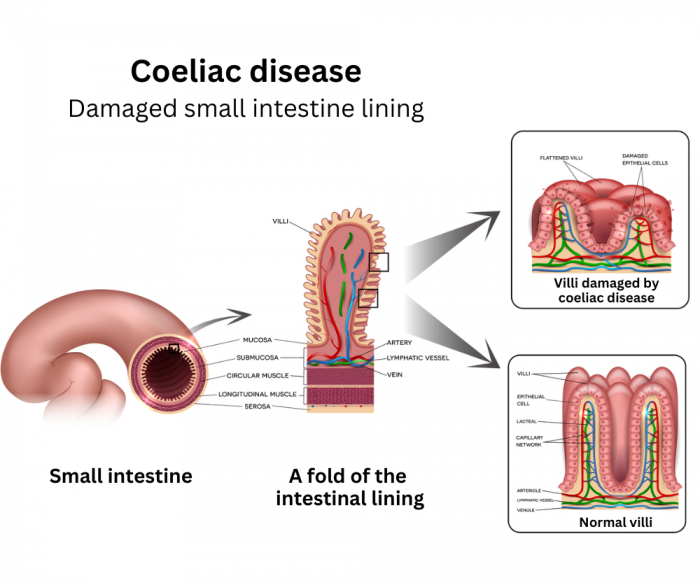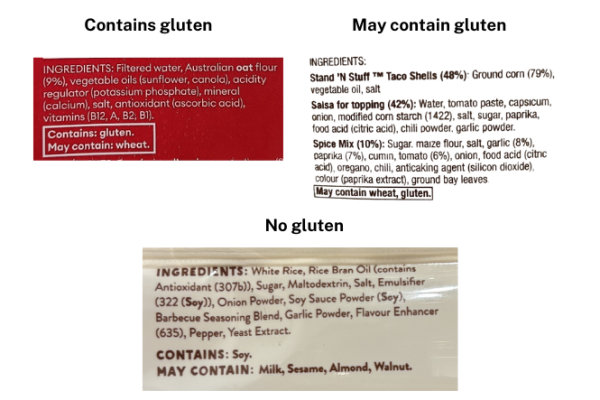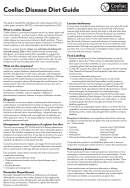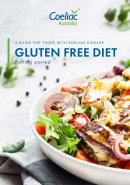Gluten-free diet
Key points about a gluten-free diet
- Gluten is a protein found in wheat, rye, barley and triticale. Oats contain a protein similar to gluten (avenin) and may be contaminated with gluten.
- Some people need to avoid gluten in their diet for health reasons, such as coeliac disease.
- Some people may be intolerant to gluten meaning that eating it results in a range of gut symptoms that could be linked to gluten, eg, abdominal pain, bloating and diarrhoea.
- A gluten-free diet contains no gluten. You should only avoid gluten if a healthcare provider has recommended you do so.

Gluten is the main protein found in the following grains:
- Wheat (including spelt, semolina, couscous, bulghur).
- Rye.
- Barley.
- Triticale.
This includes all forms of the grain including flour and fermented versions, such as sourdough. See the Coeliac NZ website(external link) for a full list of these grains and their derivatives.
Oats are not considered gluten-free in Aotearoa New Zealand because they are grown next to wheat fields, which contaminates them with gluten. They contain a protein similar to gluten (avenin) that can affect some people following a gluten-free diet. Coeliac NZ's advice is to avoid oats, even if uncontaminated, and to only add them to your diet under medical supervision.
If you are diagnosed with coeliac disease, the only effective treatment is a life-long gluten-free diet. This includes making sure you avoid hidden sources of gluten and foods that may have been cross-contaminated with gluten.
Your doctor or dietitian may also advise you to follow a gluten-free diet if you have gluten intolerance or sensitivity. You may be able to tolerate a small amount of gluten, so may not need to take so much care to avoid hidden sources of gluten or cross-contamination (see the section below).
Removing gluten from your diet without medical advice puts you at risk of missing out on important nutrients, and this can lead to other health issues. Digestive symptoms can be caused by many things, so see your doctor before self-diagnosing or changing your diet. Getting the right diagnosis is your best chance of improving your symptoms and maintaining good health in the long term.
Coeliac disease is an autoimmune condition where you react to a protein called gluten. Eating gluten causes damage to the villi lining in your gut (small intestine). This damage means you often can't absorb vitamins and minerals properly, and may cause low blood iron levels (anaemia) and weak bones (osteoporosis). Taking the gluten out of your diet lets your gut recover.

Image credit: Depositphotos
If you are diagnosed with coeliac disease, the only treatment is to follow a gluten-free diet – even if you don't have any symptoms. If you've been diagnosed, ask your healthcare provider to refer you to a dietitian to help you follow a gluten-free diet that can meet your personal nutrition needs, taking into account your medical history.
If you keep eating gluten, damage to your gut will still be happening, even if your symptoms have gone away.
If a product contains gluten or wheat it will be identified on the ingredient list and in the allergy statement (next to the ingredients list). Wheat may also be called atta, bulghur, bran, couscous, dinkel, durum, emmer, farina, German wheat, graham flour, Kamat, Polish wheat, semolina, spelt, triticale, wheat bean and wheatgerm.
Watch out for hidden gluten
Some people with coeliac disease show no improvement on a gluten-free diet. The most common reason for this is because you are still eating small amounts of gluten.
Hidden sources of gluten include:
- additives, preservatives or stabilisers made with wheat
- when there's cross-contamination from gluten-containing foods, such as breadcrumbs in the toaster (see the section below).
Apps reviewed by Healthify
You may find it useful to look at some food label reading apps and coeliac disease apps.
Gluten containing foods
Any type of food containing wheat flour, wheat, barley, rye, oats is unsuitable for people with coeliac disease.
Unless specified ‘gluten free’ these types of foods are NOT gluten free:
Burger buns, bread, cakes, biscuits, pastry, pasta, croutons, stuffing, beer, bagels, cheesecake (the biscuit base), wraps, doughnuts, buns, spaghetti, breakfast cereals, muesli, pizza, pies, crackers, gravy, breadcrumbs, foods cooked in batter.
These foods may be less obvious sources of gluten and it’s important to always check the label:
Additive 1400 (dextrin roasted starch). Baked beans, baking powder, cornflakes, dry-roasted nuts, hot chips, frozen chips, ice cream, marinated meats, rice bubbles, sausages, sauces, soups, yoghurt.
Thickeners to avoid
Thickeners (modified starches) made from wheat and raising agents made with wheat starch are not gluten free.
- Additive 1400 (dextrin-roasted starch) is made from wheat.
- Other thickeners (from 1401 to 1450) are made from maize, tapioca or potato starch and are gluten free.
Highly processed sweeteners are gluten free
Sweeteners such as caramel, dextrose, glucose, glucose syrup and maltodextrin are so highly processed and purified that the source of the starch doesn't matter. Even when made from wheat they're gluten free because of the way they've been processed.
For more information talk to a registered dietitian or visit the Coeliac New Zealand(external link) website.
Gluten and wheat is identified on all food labels in Aotearoa New Zealand and Australia. Always check the label.
To avoid gluten, it's important to learn how to read a food label so you can find the foods that are safe for you.
The Australia New Zealand Food Standards Code requires food labels to declare if the product contains gluten, eg, wheat, rye, barley (and malt derived from barley), spelt and oats. You'll see gluten in the 'contains' statement if the product contains gluten.

Image credit: Healthify He Puna Waiora
What to look for
- Products labelled as ‘gluten-free’ and with 0 g gluten stated in the nutrition information panel.
- Products with the Coeliac NZ 'Crossed Grain' logo which certifies that products are suitable for a gluten-free diet.
For a product to be classified as gluten-free in Aotearoa New Zealand it must contain no detectable gluten – defined as less than 3 parts per million of gluten.
Foods labelled as 'low gluten' or 'may contain traces of gluten' are not usually suitable for a person with coeliac disease. Check with your healthcare provider about the suitability of these products.
Always check food labels of the products before you eat them to see whether they contain any sources of gluten. Sometimes manufacturers change their products, so it's important to check the label – especially if you're on a strict gluten-free diet.
Cross-contamination occurs when gluten-free foods come into contact with foods that contain gluten.
Exposure to gluten, even in tiny amounts and with no symptoms, can cause damage to the villi lining your gut (small intestine) and increase the risk of long-term complications.
Ways to reduce the risk of cross-contamination
Packaged food products
- Cross-contamination can happen during the manufacturing process, eg, if the same equipment is used to make a variety of different products.
- Some food labels include a 'may contain' statement if cross-contamination is likely. However, this type of statement is voluntary and some products may be at risk without the manufacturer stating this.
- If you're unsure whether a food may be contaminated, don’t buy it. Check with the manufacturer first.
- If a food says it is 'gluten-free' it has been tested to be free from cross-contamination and safe to eat.
- If a food has the ‘crossed grain’ logo, it's been approved by Coeliac New Zealand to be gluten free.
Cafes and restaurants
Many cafes and restaurants offer gluten-free food, but not all of them know how to avoid cross-contamination.
- If you are unsure whether the food is safe, ask the staff about their understanding of gluten-free food and how they avoid cross-contamination. Coeliac New Zealand provide some guidance on questions to ask when dining out(external link).
- If you're not satisfied with the answers, it's best not to eat the food.
- Some cafes and restaurants have undergone gluten-free food safety training through Coeliac New Zealand. This means the venue and staff have been trained around the provision of safe gluten-free food for people requiring a gluten-free diet. Read more about the gluten-free food safety training certificate(external link).
Supermarkets and other food shops
- Be aware of the risk of cross-contamination in bulk food bins, due to people using the same scoops for food with and without gluten.
- Also watch out for cross-contamination with deli foods, eg, if staff use the same tongs for food with and without gluten.
At home
Cross-contamination can happen if foods are prepared on the same surfaces or boards as food with gluten in it, or with utensils that weren't thoroughly cleaned after being used to prepare gluten-containing foods. Toasters are also a major source of cross-contamination.
Reduce the risk of cross-contamination at home by:
- washing kitchen equipment, utensils and chopping boards after preparing foods containing gluten or use separate equipment for gluten-free food preparation
- wiping surfaces down well with hot, soapy water after preparing foods containing gluten
- keeping gluten-free food and food with gluten in separate areas in your kitchen – putting the gluten-free food higher in the cupboard makes it less likely to get crumbs/flour etc from gluten-containing foods spilled on it
- using a washable silicon mat on cooking surfaces that may be contaminated with gluten, eg, barbeques
- using toaster bags or a separate toaster for gluten-free bread
- having separate containers of butter/margarine, spreads and chutneys for those on a gluten-free diet.
Some gluten-free diets can be low in nutrients including, fibre, calcium, vitamin D, vitamin B12, folate or iron.
Many whole foods are naturally gluten-free and are the best foods to eat on a gluten-free diet. Eating a wide range of these foods will help you to meet your nutrition needs.
Examples of naturally gluten-free whole foods include:
- fresh fruit and vegetables, including potatoes and other starchy vegetables
- milk, yoghurt and cheese
- high-fibre grains such as brown rice, quinoa, buckwheat, millet
- chickpeas, lentils and beans
- meat, chicken, fish and seafood
- eggs
- butter and oils
- nuts and seeds.
Many people believe that a gluten-free diet is healthier, but there's no reason to avoid gluten unless directed by a healthcare provider following diagnosis of coeliac disease, gluten intolerance, or another condition affected by gluten.
These videos have been created by Coeliac New Zealand(external link). As playback on other websites has been disabled by the video owner, you need to click on the video name to watch them on YouTube.
- Setting up a gluten free pantry(external link) (6 mins)
- Easy gluten free product substitutions(external link) (6 mins)
- Cross contamination and how to control it(external link) (5 mins)
- Gluten free flour and baking tips(external link) (5 mins)
- Buddy shopper – label reading made easy(external link) (9 mins)
For more videos in the same series, visit Coeliac NZ on YouTube(external link).
Coeliac New Zealand(external link) is an excellent source of current advice and resources to help you navigate a gluten-free diet.
- Membership benefits include receiving the Coeliac Link magazine and monthly e-newsletters along with access to member only educational and support resources. Find out more about member benefits(external link).
- New members receive in-depth information and tools to make the transition to a gluten-free diet as easy as possible.
Coeliac disease self-assessment survey(external link) Coeliac NZ
How to eat gluten free(external link) Coeliac NZ
Gluten free recipes(external link) Coeliac NZ
Gluten(external link) NZ Nutrition Foundation
Deliciously gluten free – gluten free baking, snacks and desserts(external link) My Food Bag & Coeliac New Zealand
Brochures
Coeliac disease(external link) Coeliac NZ
Coeliac disease diet guide(external link) Coeliac NZ
A guide for those with coeliac disease – gluten free diet(external link) Coeliac Australia
Apps
Coeliac disease apps
Food label reading apps
References
- Allergy New Zealand(external link)
- Coeliac New Zealand(external link)
- Coeliac disease – investigation and management(external link) BPAC, NZ, 2022
Brochures

Coeliac disease
Coeliac NZ

Coeliac disease diet guide
Coeliac NZ

A guide for those with coeliac disease – gluten free diet
Coeliac Australia
Credits: Healthify editorial team. Healthify is brought to you by Health Navigator Charitable Trust.
Reviewed by: Lily Henderson Registered Dietitian; Suzanne Aitken, Registered Dietitian, Dietary Education Manager, Coeliac New Zealand
Last reviewed:





